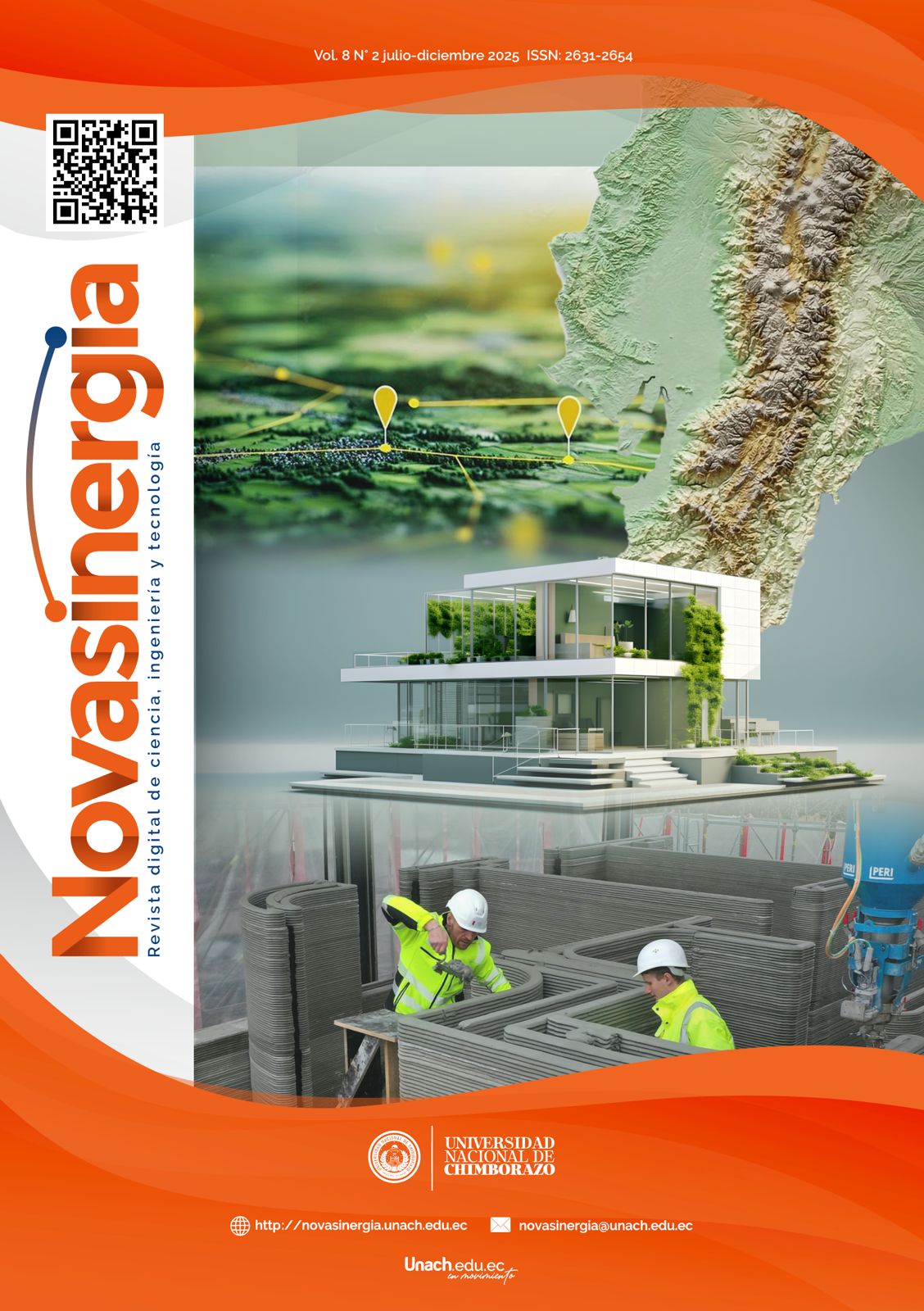From simulation to construction: optimization of materials and energy in sustainable housing with BIM
DOI:
https://doi.org/10.37135/ns.01.16.07Keywords:
bim, energy efficiency, construction materials, Sustainability, social housingAbstract
Energy efficiency and sustainability in social housing depend on material selection. This study explores the potential of using Building Information Modeling (BIM) in combination with sustainable materials to identify strategies that could reduce energy consumption and carbon footprint in tropical climates based on digital analysis conducted during the design phase. A social housing unit was modeled using Revit 2025, and its thermal and environmental performance was evaluated through Revit Insight. Additionally, a database was developed to compare the thermal, mechanical, and environmental properties of both conventional and sustainable materials. Simulation results indicate that bamboo, with thermal conductivity of 0.12 W/m·K and thermal resistance of 8.33 m²·K/W, and enhanced glass, with 0.78 W/m·K and 1.28 m²·K/W, show better thermal performance and lower environmental impact compared to structural concrete (1.75 W/m·K, 0.57 m²·K/W, and 150 kg CO₂/m²). Steel, with 50.2 W/m·K and 250 kg CO₂/m², is identified as the material with the highest environmental impact. The optimized housing model reduced thermal envelope energy consumption from 85 kWh/m²/year to 70 kWh/m²/year, with an estimated 20% decrease in cooling demand. It is concluded that integrating BIM with structured material databases supports decision-making in architectural design and promotes the development of more efficient and sustainable housing solutions in tropical regions.
Downloads
References
.[1] A. Lyons, Modern Methods of Construction and Innovative Materials. New York: Routledge, 2024. doi: https://doi.org/10.1201/9781003360469.
.[2] N. S. Pardo, G. L. Penagos, y H. Acevedo, “Impactos Ambientales Asociados a la Huella de Carbono y la Energía Incorporada del Ciclo de Vida de una Edificación en Medellín,” Inf. Constr., vol. 74, no. 565, p. e436, mar. 2022, doi: https://doi.org/10.3989/ic.82758.
.[3] A. Alsehaimi et al., “Building a Sustainable Future: BIM’s Role in Construction, Logistics, and Supply Chain Management,” Ain Shams Eng. J., vol. 15, no. 12, p. 103103, dic. 2024, doi: https://doi.org/10.1016/j.asej.2024.103103.
.[4] K. S. Satyanarayanan, H.-J. Seo, y N. Gopalakrishnan, Sustainable Construction Materials: Select Proceedings of ACMM 2021. Springer: Singapore, 2022. doi: https://doi.org/10.1007/978-981-16-6403-8.
.[5] G. Manzaba-Carvajal, R. Valencia-Robles, M. Romero-Jara, y C. Cuenca-Márquez, “Modelado BIM en el Diseño Residencial: Estrategias Paramétricas de Arquitectura Digital,” in Jornadas sobre Innovación Docente en Arquitectura JIDA’24, Universitat Politècnica de Catalunya, nov. 2024. doi: https://doi.org/10.5821/jida.2024.13318.
.[6] C. B. C. S. Alvarenga, O. M. Heiderick, T. A. Couto, P. R. Cetlin, R. B. C. Sales, y M. T. P. Aguilar, “Influence of Soda-Lime Waste Glass Microparticles on Workability and Thermal Properties of Portland Cement Compounds,” Mater. Constr., vol. 69, no. 335, p. e192, sep. 2019, doi: https://doi.org/10.3989/mc.2019.05818.
.[7] E. Fraile-García, J. Ferreiro-Cabello, and F. J. Martinez de Pison, y “Effects of Design and Construction on the Carbon Footprint of Reinforced Concrete Columns in Residential Buildings,” Mater. Constr, vol. 69, no. 335, p. e193, sep. 2019, doi: https://doi.org/10.3989/mc.2019.09918.
.[8] J. Sánchez-Molina, F. A. Corpas-Iglesias, y J. P. Rojas-Suárez, “Cenizas Volantes de Termoeléctrica Como Materia Prima para la Fabricación de Materiales Cerámicos de Construcción: Efecto de la Temperatura de Cocción sobre el Material,” Inf. Tecnol., vol. 30, no. 1, pp. 285–298, feb. 2019, doi: https://doi.org/10.4067/S0718-07642019000100285.
.[9] J. Bredenoord, “Bamboo as a Sustainable Building Material for Innovative, Low-Cost Housing Construction,” Sustainability, vol. 16, no. 6, p. 2347, mar. 2024, doi: https://doi.org/10.3390/su16062347.
.[10] G. F. Huseien y K. W. Shah, Sustainable Nanomaterials for the Construction Industry. Boca Raton, FL: CRC Press, 2023. doi: https://doi.org/10.1201/9781003281504.
.[11] N. H. Dinh, H. H. Pham, S.-H. Kim, y K.-K. Choi, “Tensile Performance and Cracking Characteristics of Sustainable Textile-Reinforced Cementitious Composites Utilizing Expanded Glass Aggregate and Fly Ash Replacement,” Constr. Build. Mater., vol. 425, p. 136084, abr. 2024, doi: https://doi.org/10.1016/j.conbuildmat.2024.136084.
.[12] Y. Li et al., “Assessing Carbon Emissions of Facility Agriculture Involving Photovoltaic Greenhouses – Insights from Table Grapes Cultivation,” Carbon Neutr., vol. 4, no. 1 p. 4, ene. 2025, doi: https://doi.org/10.1007/s43979-025-00118-x.
.[13] N. Chang et al., “Mechanical Strength, Hydration Products, and Microstructure of Waste-Derived Composite-Activated Cementitious Materials by Varying Titanium Gypsum Phase Composition,” Constr. Build. Mater., vol. 456, p. 139328, dic. 2024, doi: https://doi.org/10.1016/j.conbuildmat.2024.139328.
.[14] K. Wang, S. Guo, H. Yuan, J. Ren, P. Chen, y Q. Zhang, “Influence of Cement Particle Size, Ultra-Fine Fly Ash, and Ultra-Fine Silica Fume on the Physical and Microscopic Properties of Slurry,” Case Studies in Construction Materials, vol. 22, p. e04337, jul. 2025, doi: https://doi.org/10.1016/j.cscm.2025.e04337.
.[15] A. C. de Jesus Tainara y M. F. F. M. Barreto, “Análise Comparativa dos Sistemas Construtivos em Alvenaria Convencional, Alvenaria Estrutural e Moldes Isolantes para Concreto (Icf),” E&S Eng. Sci., vol. 7, no. 3, pp. 12–15, sep. 2018, doi: https://doi.org/10.18607/ES201876926.
.[16] Y. Xu, T. Xu, G. Li, y T. Xie, “Modeling Smeared Fiber-Matrix Pullout Strength of Steel Fiber-Reinforced Concrete with Various Types of Steel Fiber and Its Tensile and Compressive Strength,” Case Studies in Construction Materials, vol. 22, p. e04242, jul. 2025, doi: https://doi.org/10.1016/j.cscm.2025.e04242.
.[17] M. Abu-Bakr, H. F. Mahmood, A. A. Mohammed, y S. A. Ahmed, “Evaluation of Mechanical Properties and Shear-Bond Strength of Mortar Containing Natural Extract,” Constr. Build. Mater., vol. 418, p. 135377, mar. 2024, doi: https://doi.org/10.1016/j.conbuildmat.2024.135377.
.[18] K. Kalinowska-Wichrowska, C. Piña Ramírez, y A. Vidales Barriguete, and, “La segunda vida de los residuos de construcción. Propuesta para reutilizar como agregado árido reciclado y residuos de material aislante,” An. Edif., vol. 5, no. 2, pp. 1–8, ago. 2019, doi: https://doi.org/10.20868/ade.2019.4039.
.[19] R. Pöttgen, T. Jüstel, y C. A. Strassert, Eds., Applied Inorganic Chemistry, Volume 1: From Construction Materials to Technical Gases. Berlin: Walter de Gruyter GmbH, 2023. doi: https://doi.org/10.1515/9783110733143.
.[20] A. Shahrokhi, M. Adelikhah, S. Chalupnik, E. Kocsis, E. Toth-Bodrogi, y T. Kovács, “Radioactivity of Building Materials in Mahallat, Iran – An Area Exposed to a High Level of Natural Background Radiation – Attenuation of External Radiation Doses,” Mater. Constr, vol. 70, no. 340, p. e233, nov. 2020, doi: https://doi.org/10.3989/mc.2020.03820.







